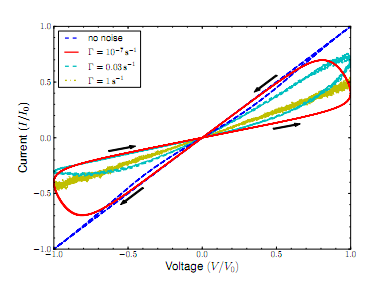Next Generation Memories Will Be Improved By Noise
The mathematical foundations of electronics predict the existence of four fundamental electronic devices. The resistor, capacitor and inductor are well known. The fourth device, the memristor, was only discovered in 2008 and even now remains an exotic piece of kit.

Memristors are electrical elements whose resistance depends on the current that has passed through it in the past, a phenomenon that physicists call a hysteresis. This makes these devices behave like resistors with memory, hence their name.
Memristors have generated considerable interest because they are simple and cheap to make, operate quickly and at low power and have the potential to store information even when the power is switched off.
So it’s no surprise that great things are expected of them and that various plans are afoot to build them into future generations of microchips.
But there’s a potential fly in the ointment: noise.
In practice, the behaviour of memristors is quite simple. Plot the voltage across a memristor against the current flowing through it and you’ll get a figure-of-eight curve like the one above.
It’s easy to imagine that noise could swamp this effect, destroying the memory that makes memristors so useful.
Today, Alexander Stotland and Massimiliano Di Ventra at the University of California-San Diego, reveal a comprehensive analysis of the effects of noise on memristors. Their conclusion is both surprising and reassuring. Not only should memristors be immune to most types of noise, their memory ought to be enhanced by it.
Stotland and Di Ventra calculate that high frequency noise has little effect on memristance because the device cannot respond quickly enough to the changes that this noise produces. Low frequency noise also has little effect because it produces changes that are too slow to effect the memory.
However, there is an intermediate range of noise that has a significant effect on memristance. But far from destroying memristance, Stotland and Di Ventra calculate that it should amplify it by making the hysteresis curve wider. In effect, this type of noise improves memristance.
This is analogous to another well known effect of noise known as stochastic resonance, in which the sensitivity of certain systems is improved by noise. Stotland and Di Ventra call their new effect stochastic memory.
Stotland and Di Ventra go on to say that their theory can be easily tested. One important source of noise in any electronic system is temperature. So changing the temperature of a memristor should effect its memristance in a characteristic way.
Exactly how depends crucially on the physics behind the memristance, on exactly what causes the hysteresis curve.
That could be useful. The precise mechanism behind memristance is not known in some systems, so this kind of experiment could help pin down exactly what kind of physics is involved.
The role of noise may have important implications for other fields of science. It turns out that the electrical behaviour of synapses, the gaps between neurons, is identical to a memristor’s. So it seems as if memristance must play a fundamental role in the way our body and brain processes information.
Neurologists have often wondered why our information processing system is so robust to the noise that must bombard it.
Perhaps Stotland and Di Ventra’s ideas will show that neurons are not just robust against noise, they actually depend on it to work effectively.
There are already a number of research programs to study and exploit memristance in making chips that can mimic the behaviour of neural circuits. So we may not have to wait long to find out.
You can now follow the Physics arXiv Blog on Twitter
Keep Reading
Most Popular
Large language models can do jaw-dropping things. But nobody knows exactly why.
And that's a problem. Figuring it out is one of the biggest scientific puzzles of our time and a crucial step towards controlling more powerful future models.
The problem with plug-in hybrids? Their drivers.
Plug-in hybrids are often sold as a transition to EVs, but new data from Europe shows we’re still underestimating the emissions they produce.
How scientists traced a mysterious covid case back to six toilets
When wastewater surveillance turns into a hunt for a single infected individual, the ethics get tricky.
Google DeepMind’s new generative model makes Super Mario–like games from scratch
Genie learns how to control games by watching hours and hours of video. It could help train next-gen robots too.
Stay connected
Get the latest updates from
MIT Technology Review
Discover special offers, top stories, upcoming events, and more.